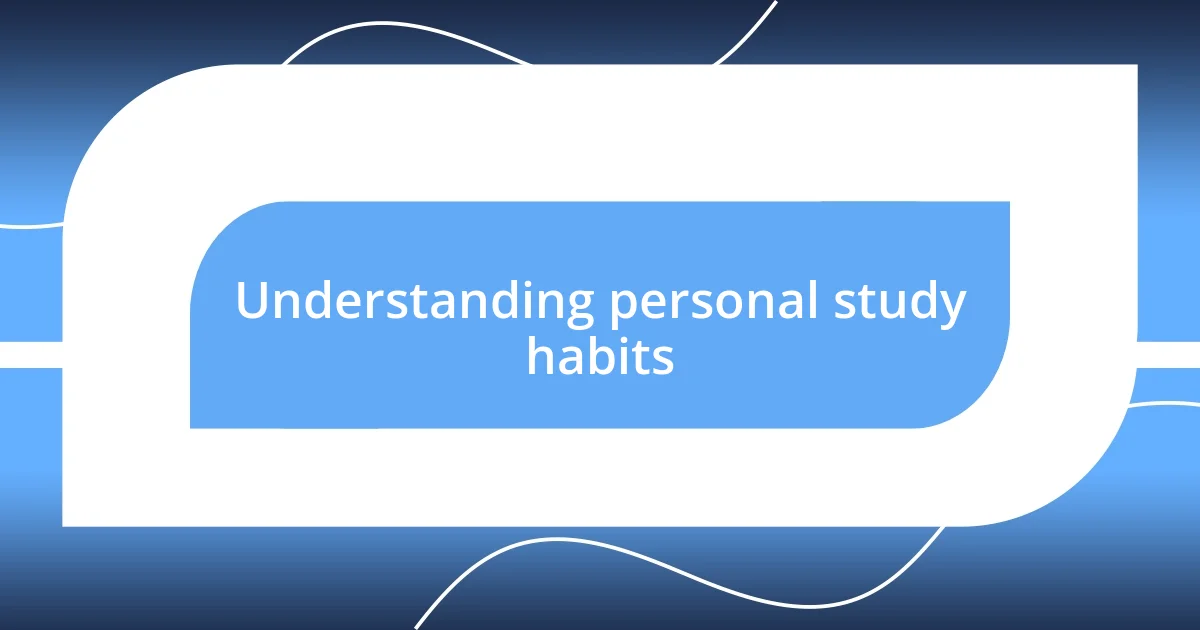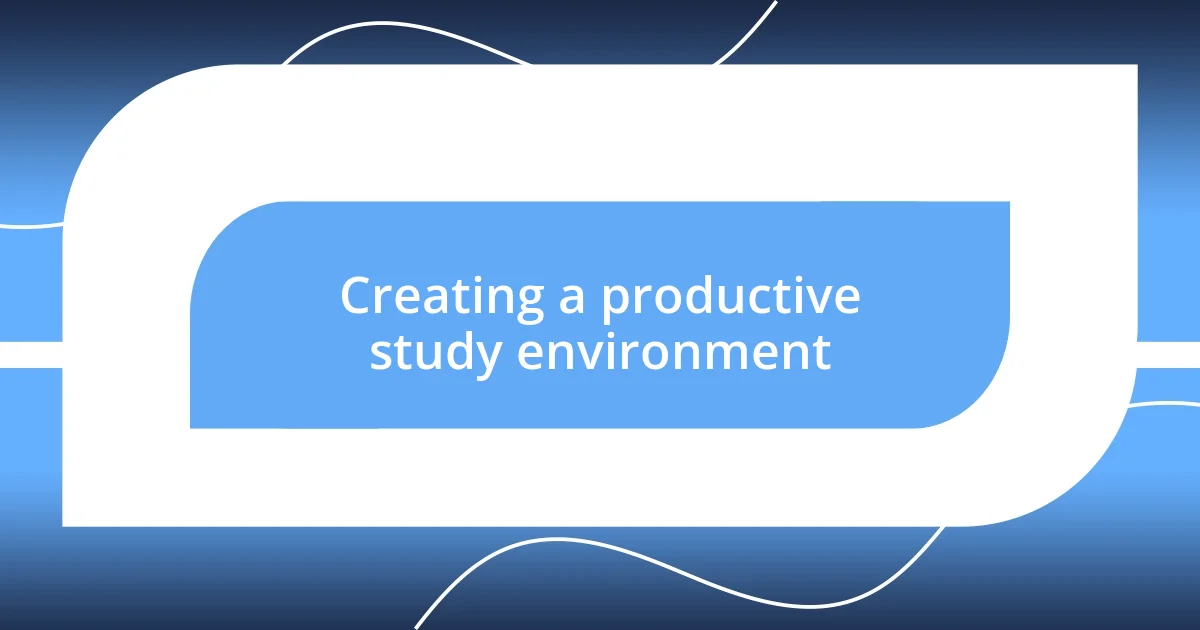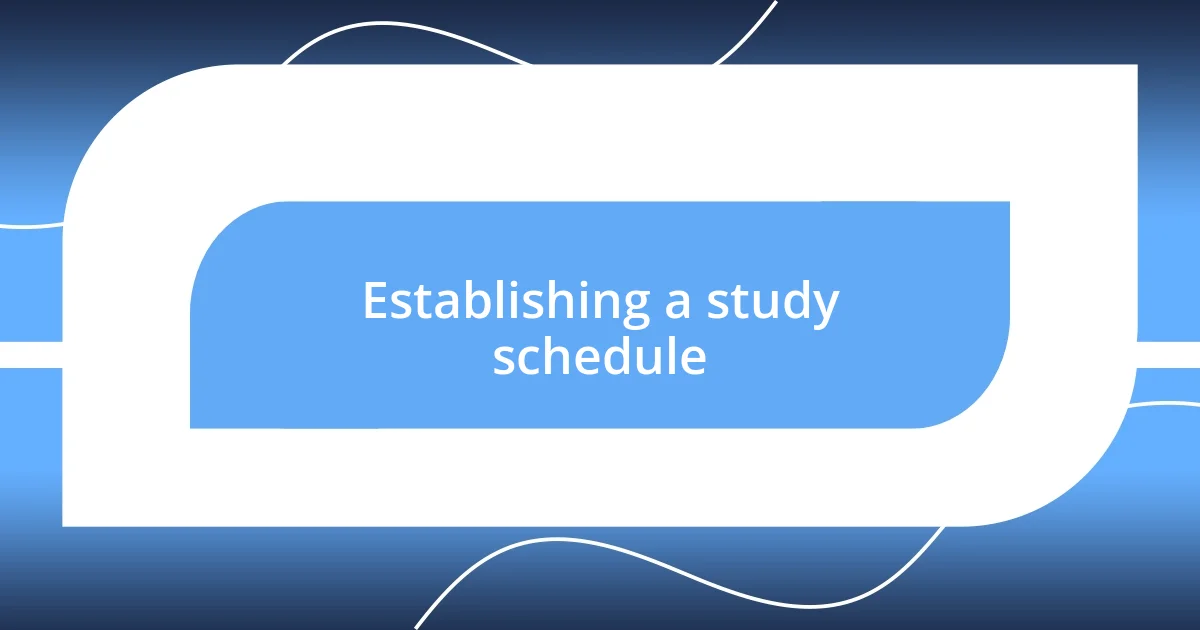Key takeaways:
- Understanding personal study habits, like creating a quiet environment and breaking tasks into smaller segments, significantly boosts focus and retention.
- Utilizing effective study techniques such as mind mapping, spaced repetition, and collaborative learning enhances comprehension and retention of material.
- Establishing a flexible study schedule with built-in breaks and a dedicated study area promotes productivity and reduces stress during study sessions.

Understanding personal study habits
When I first started studying, I often felt overwhelmed by the sheer volume of material I needed to cover. It wasn’t until I took the time to understand my personal study habits that I began to see improvement. I realized that I thrived in quiet environments and needed to eliminate distractions, which made a significant difference in my focus and retention.
Another key insight I discovered is the power of breaking tasks into smaller chunks. Instead of trying to cram all night for a test, I began setting specific goals for my study sessions. Have you ever noticed how much easier it is to sit down when you know you only have to focus for 25 minutes? This approach, often referred to as the Pomodoro Technique, transformed my study routine into a more manageable and less daunting process.
Reflecting on my past experiences, I’ve found that incorporating varied study methods keeps things fresh and engaging. For instance, I would switch between reading, flashcards, and discussing topics with a friend. This not only helped reinforce what I was learning but also made studying feel less like a chore and more like an exciting exploration. What strategies have you tried that have truly clicked for you?

Identifying effective study techniques
Identifying effective study techniques requires a blend of trial and reflection. I remember trying different methods, from reading textbooks to watching educational videos. The turning point for me was discovering how visualization techniques, like mind mapping, helped me organize and remember information more effectively. Suddenly, complex topics became clearer, and I felt more in control of my learning journey.
Another approach I found particularly helpful was the spaced repetition method. I used to review my notes only a few days before exams, which led to a lot of stress and anxiety. Once I started revisiting material over spaced intervals, I noticed greater retention and less cramming. It was as if I’d unlocked a more relaxed and effective way of studying – the act of learning transformed from a sprint to a marathon.
I also experimented with collaborative learning environments. Personally, studying with peers not only made the process more enjoyable, but it also opened up avenues for new perspectives. Engaging in discussions often sparked deeper understanding of the material. Have you thought about how interacting with others could enhance your learning experience? Sharing insights and teaching one another can help solidify your understanding and build confidence.
| Study Technique | Description |
|---|---|
| Mind Mapping | A visual tool to organize ideas and make complex topics clearer. |
| Spaced Repetition | Reviewing material over consistent intervals to enhance retention. |
| Collaborative Learning | Studying with peers to benefit from diverse perspectives and discussions. |

Creating a productive study environment
Creating a productive study environment involves more than just having a desk and books. I remember when I finally settled into a dedicated space just for studying — it was a game changer. The combination of good lighting and a tidy desk equipped with everything I needed made all the difference. I felt more relaxed and focused, free from the distractions of daily life.
To create your own productive study environment, consider these elements:
- Comfortable Furniture: Invest in a good chair and desk; you’ll be sitting for a while.
- Minimal Distractions: Keep your phone out of reach and limit noise. Noise-canceling headphones can be a lifesaver for me.
- Personal Touches: Add a few inspiring decorations, like motivational quotes or photos, which can uplift your mood.
- Organized Supplies: Keep your study materials neat. I’ve noticed that clutter can drain my motivation.
- Dedicated Zone: If possible, designate a specific area that’s solely for studying. This helps signal your brain that it’s time to focus.
With these tactics, my study sessions transformed from feeling like a chore to becoming a time I actually looked forward to.

Establishing a study schedule
Establishing a study schedule has been a real game changer for me. I remember the chaos of unplanned late-night cramming sessions, feeling overwhelmed and unproductive. Once I started blocking out dedicated study times in my calendar, everything shifted. It wasn’t just about the hours—I began to prioritize my most challenging subjects when I had the most energy, and surprisingly, my comprehension shot up.
I also found it helpful to build in breaks. Initially, I had this rigid view of studying—more hours, more success—but my experience taught me that the mind needs breathing room. Taking those short breaks to stretch or grab a snack not only rejuvenated me but also increased my focus when I dove back into studying. Have you ever noticed how stepping away for a moment can refresh your thoughts?
Flexibility has been another essential aspect of my study schedule. Life happens, and I’ve had my fair share of unexpected events that threw my plans off track. Instead of feeling defeated, I learned to adjust my schedule, making it a living document that could evolve with my needs. This adaptability helped me stay committed without feeling stressed—because at the end of the day, it’s about making progress, not squeezing in every minute!

Utilizing study aids and resources
Utilizing study aids and resources has been pivotal in enhancing my learning experience. I vividly recall the first time I discovered flashcards; it was like a light bulb went off in my mind. The act of crafting my own cards not only helped me memorize definitions but also engaged my creativity as I designed mnemonics that made the information stick. Have you ever felt that thrill when a study tool genuinely enhances your understanding? For me, it was incredibly satisfying.
Another resource I’ve leaned on is online study groups. When I initially joined one, I was apprehensive—would I really get anything out of it? However, collaborating with peers opened up a whole new perspective on the material. Talking things through not only clarified my understanding but also made learning more enjoyable. I often find it helpful to hear explanations from my peers; they sometimes present concepts in a way that clicks better than textbooks ever could. Don’t you think that learning with others can transform the experience from solitary to something truly communal?
Lastly, I can’t overlook the power of technology in my studies. From educational apps that track my progress to virtual tutors who give feedback on my work, these resources have become indispensable. For example, using an app that includes practice quizzes has greatly boosted my confidence before exams. It’s amazing how something as simple as a digital tool can create a sense of preparedness. Do you feel like technology is reshaping your study habits, too? In my case, it’s been a game changer, and I suspect it could be for you as well.

Practicing active learning strategies
Practicing active learning strategies has truly transformed my approach to studying over the years. One strategy that stood out for me was summarizing what I had just learned. Picture this: after finishing a dense chapter, I’d put the book away and tell myself to summarize key points out loud, as though I was teaching. I was surprised at how much better the information stuck! Have you ever tried explaining concepts to someone else? It’s incredible how this method forces you to distill complex ideas into digestible bits.
I also found incorporating real-life applications into my studies to be immensely beneficial. Whether it was relating historical events to current issues or applying mathematical concepts to everyday situations, connecting abstract ideas to the real world gave them purpose. I vividly remember grappling with statistics until I realized I could apply those concepts to my part-time job analyzing sales data. Suddenly, statistics wasn’t just numbers on a page; it became a powerful tool in my professional toolkit. How engaging does it feel when you see the relevance of what you learn in your own life?
Another effective strategy for me has been using collaborative techniques, like peer teaching. Teaming up with classmates and taking turns teaching each other the material not only deepened my understanding but also created a sense of camaraderie. Once, while studying for a biology exam, my study buddy and I role-played as knowledgeable professors, passionately explaining cellular processes to each other. It felt less like studying and more like a fascinating conversation, revitalizing our enthusiasm for the subject matter. Have you ever experienced that joy when studying becomes a shared adventure? For me, it’s one of the best ways to reinforce what I know while gaining fresh perspectives.












